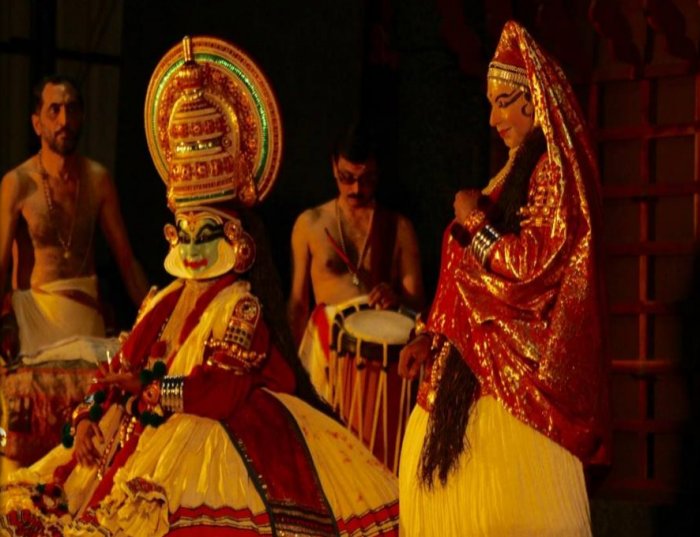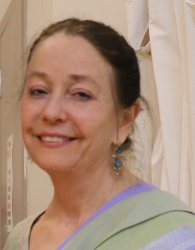
|   |

|   |
 e-mail: janakipatrik@gmail.com UPAJ - Part II - NRITYA (Section # 1) November 26, 2023 In my two-part essay entitled "UPAJ - Improvisation in Kathak", written for Narthaki Online, I endeavor to demystify Kathak's rhythmic and storytelling improvisational processes. I suggest that improvisation is an art which is learned and practiced - an art which is not limited only to those who are "born with it". UPAJ - Part I - NRITTA examines the structures in Kathak dance, which support rhythmic improvisation. The essay you are now reading - UPAJ - Part II - NRITYA -- examines the techniques and performance practices, which support improvisation in Kathak storytelling. MEMORIES I arrived at Palam Airport in the muggy, pre-monsoon heat of July 1967. It was the beginning of my first trip to India to study Kathak at Kathak Kendra with Maharaj ji (later honored as Padma Vibhushan Pandit Birju Maharaj). I lived with the Garga family in staff housing on the grounds of Bal Bhavan, the National Children's School, which had been founded by Nehru and was located a short walk from Kathak Kendra. Poppa Garga, Director of the Art Department of Bal Bhavan, had been awarded a Rockefeller grant to study in the United States in the mid-1960s. To return the hospitality he had experienced in New York City from one of my friends, Poppa and his wife welcomed me into their family like an elder sister of their three children. On August 28, 1967 - only a few weeks after I arrived in India -- Poppa took me to old Delhi to visit his friend, the Mahant of a little temple in the narrow alleys behind the Jama Masjid, the great mosque of Old Delhi. Everything about this visit appeared new and strange to me. From the outside the temple looked like an old 4-story house squeezed among other old houses in a noisy alley. We were greeted by Poppa's friend, who wore ordinary pants and a loose over-shirt, not the white dhoti worn by Poppa's friend the Pandit, who had helped me translate the Guru Vandana I had learned during my first class with Maharaji. In the largest room of the Mahant's small temple-house, a simple altar had been built and covered with flashy brocade. Statues of gods whose names I didn't yet know were placed amidst flowers, fruits and fragrant incense. A little stage had been set up outside in the crowded chowk - the crossroads where the temple-in-a-house was located. As midnight approached, the crowd got bigger and bigger and excitement mounted. Then children and adults dressed in bright, tinseled costumes came out of the Mahant's house-temple, mounted the stage and began singing and dancing and enacting a play about Krishna's birth. Poppa told me that today was a holiday named Janmashtami, and that Krishna's birth would be celebrated just before midnight. The exuberant, noisy joy of the scene was in stark contrast to the quiet reverence of an outdoor enactment of Christ's birth, which I had witnessed in the freezing midnight cold of rural Illinois - a state in mid-western United States. Here in Delhi, at the time designated as the moment of Krishna's birth, frenzied joy broke out in the crowd. People sang and shouted and danced and threw flowers and touched the feet of the actors on stage. Startled babies cried in their parents' arms and children ran around shaking noise-makers. The street was jammed with sweaty, smiling people, celebrating the moment when god appeared as a human on earth.  Traditional Rasaleela performance in Vrindavan (Kothari, p5) This was the first of many Krishna leelas which I experienced in India - dramatic enactments of the "divine play" - the leela - of Krishna. I even experienced the Krishna leela at Shri Chaitanya Prem Sanstaan in Vrindavan, located 115 miles outside Delhi and said to be the birthplace of Krishna. But the wild shouting and dancing and clanging of bells and blowing of conch shells and frenzied, joyful celebrations of all these other Krishna leelas always took me back to that first, simple leela, which I had experienced in 1967 on a little stage in Old Delhi. Poppa had shown me the roots of the katha in Kathak - the stories and their telling in Kathak. INCARNATION - Avataar Classical Indian dance storytelling techniques were developed in great part to lead devotees to experience the spiritual world - to transcend the boundaries of our earthbound, physical existence and experience the presence of the divine spirit. But conversely, we flesh-bound humans want tangible proof of the divine spirit - we yearn to touch and see. Katha in Kathak -- storytelling in Kathak - brings the dancer to the heart of the paradoxical experience of summoning the invisible to manifest in the visible world. At the core of many of our stories - those about deities including Krishna and Ram - is the concept of avataar - divine beings, who embody the powers of overarching deities including Vishnu and Shiva, and they take human form. Avataar is a Sanskrit compound word composed from two roots: the prefix AVA - meaning "away, down", and the verb TAARNAA - meaning "to enable to cross, to take one across". These roots join in the word avataar, which is defined as "descent". According to the Hindu concept of avataar, deities descend from the invisible divine realm and cross the boundary between spirit and body. They manifest as flesh-and-blood humans in the physical world, and they save their human devotees from misfortune and evil. In fact, avataars often save their human devotees BECAUSE they are flesh-and-blood. For example the demon Raavana asked Lord Shiva for a boon of invincibility. But Raavana's arrogance was so overwhelming, that he did not include being killed by human beings, whom he considered too weak to be a threat. And so the all-pervading protector Lord Vishnu incarnated as the human being Lord Ram, so that Raavana would be killed by a human. When human beings "play" - that is, embody -- divine beings in dramatic productions named Krishna leelas and Ram leelas ("stories of Krishna's and Ram's divine play"), human actors take part in a process similar to that described in the concept of avataar. They bring "beings" - divine, demon, human, animal -- out of the invisible world of the mind and into the physical world. In this process, our storytelling techniques help the devotee to experience the presence of the unseen - including the unseen divine -- in tangible form. EMBODIMENT - Pratimurti Classical Kathak storytelling is a solo art - NRITYA, not NAATYA. In contrast to Naatya dramas in which each character is played by a separate actor and physical props may fill the stage and painted backdrops may help create the physical setting of the story, our Kathak Nritya performances tell stories by using our own singular body on an empty stage. With the instrument of our body, we create a setting; people the stage with a cast of human, divine, mythological and animal characters; suggest the internal world of the characters' thoughts, emotions and motivations; then set the characters in motion in a physically invisible world. The success of our Kathak storytelling depends on our ability to convince the audience to "suspend disbelief" - to take a journey of the imagination - to visualize a story enacted in a world which does not physically exist, except in the single physical body of the dancer. To hold the audience's attention, the Kathak dancer establishes the central elements - characters, setting, motivation, plot - with utmost clarity and brevity, assigning a signature gesture, or gesture sequence, and a consistent position-in-space for each character, object and natural, atmospheric setting. The consistency of a dancer's focus and gestures and "positioning" of each character and object helps the audience to "keep track" of an unseen reality as the story unfolds. What are the techniques we use to make our characters and their stories "believable"? Finding the answer to this fundamental question is a central quest of UPAJ - PART II - NRITYA. And in this quest I have returned repeatedly to the concept of EMBODIMENT [1], a word which carries heavy baggage. Academicians talk of dance as "embodied practice", and popular parlance conceives of dance as an "embodiment of culture". But what is "embodiment"?
In Kathak, as well as other styles of classical Indian dance storytelling, I would define "embodiment" as the dancer's process of giving a transitory physical form to the characters, objects and driving forces in the story she is telling. Embodiment enables a story to be enacted on the physical plane of human existence, rather than remaining in the mental realm of imagination. This may seem contradictory, since Kathak nritya proceeds without any physical objects on the stage except one single dancer, who must embody every element of a story, whether animate or inanimate. Moreover, Kathak storytelling must also visually depict the changing characteristics of characters as they interact with each other. Consequently, the single dancer must transform her postures, gaits, facial expressions and gestures to reflect character development during the passage of condensed time. For example, while embodying Raavana and Sita in the Sita haran episode of the Ramayana, the dancer must visually depict the transformation of Raavana's ingratiating posture as a beggar into the ferocious, overpowering presence of a demon; and the transition from Sita's respectful bending toward a holy man into her shrinking, fearful posture as she pulls back, away from Raavana as he lunges to abduct her.  Dr.Janaki Nair dancing the male role of Bhima in an episode of Mahabaratha (L front) As far as the practical methodology for achieving embodiment in dance is concerned, a lecture-demonstration presented by Dr. Janaki Nair [2] at the 2022 Fulbright conference in Washington, DC proved most illuminating. A rare female Kathakali performer with a PhD in visual anthropology, Dr. Nair's practice-based research explores the concept of embodiment, its aligning psychophysical practices and methodologies.
In her lecture, entitled "Women in Kathakali and Embodying Character: Reflections on the female dancer's creative process in Kathakali", Dr. Nair analyzed her Kathakali training and illuminated the techniques her Guru Nelliyodu Vasudevan Nampoothiri taught for embodying characters, no matter what a dancer's gender or physical makeup might be. Dr. Nair identified five core elements in the process of embodying characters: 1) psycho-physical preparation for the mind's imaginative engagement with the characters, 2) use of space, 3) control of breath, 4) projection of energy levels congruent with each character, and 5) creation of a sense of time. To this list I have added two more ancillary elements, namely 6) the language of hand gestures / hasta mudras and 7) depiction of emotional states - the nava rasa. All of these elements will be discussed, though not necessarily in the order listed above. While a list cannot exhaust all the Kathak techniques which we use for bringing characters to life in our stories, a list does create a structure within which a meaningful examination of embodiment, and its relevance to improvisation, can be discussed. UPAJ - Part II - NRITYA (Section # 2)  Trained in both classical Kathak dance (Pt. Birju Maharaj, beginning 1967) and Merce Cunningham modern dance technique (1971 to 1978), Janaki Patrik has choreographed thirty full-evening productions and numerous shorter works exploring an eclectic range of poetry, mythic storytelling and music. She is the Artistic Director and Founder (1978) of The Kathak Ensemble & Friends/CARAVAN, NYC. A dedicated teacher, Janaki has trained dancers to perform an extensive repertoire of classical Kathak, as well as her new choreography. Teaching and performing in inner-city schools through Urban Gateways/Chicago and Young Audiences/New York for forty years, Janaki has embodied the power of dance and music to communicate the interconnections of all cultures. Post your comments Please provide your name along with your comment. All appropriate comments posted with name & email id in the blog will also be featured in the site. |